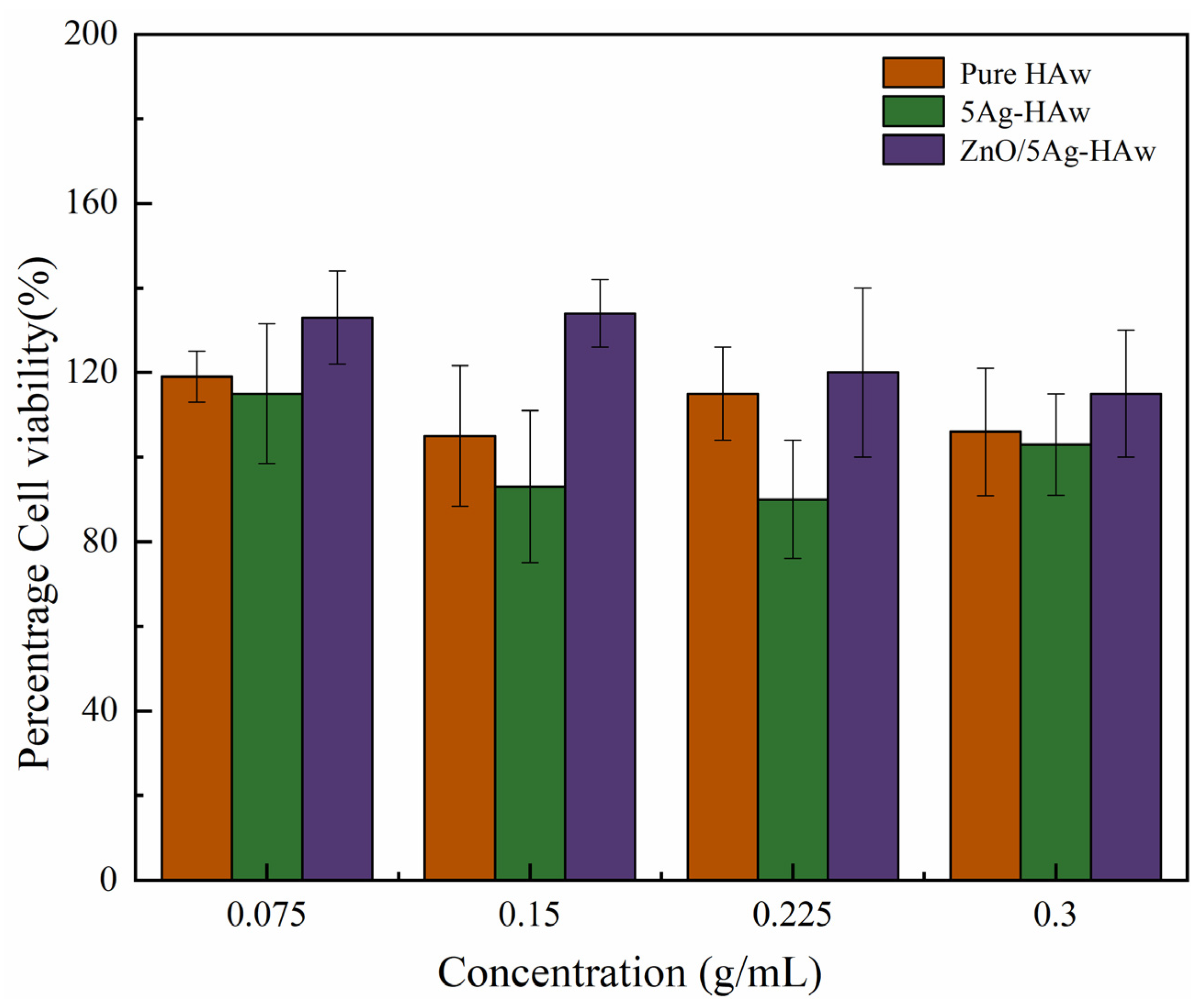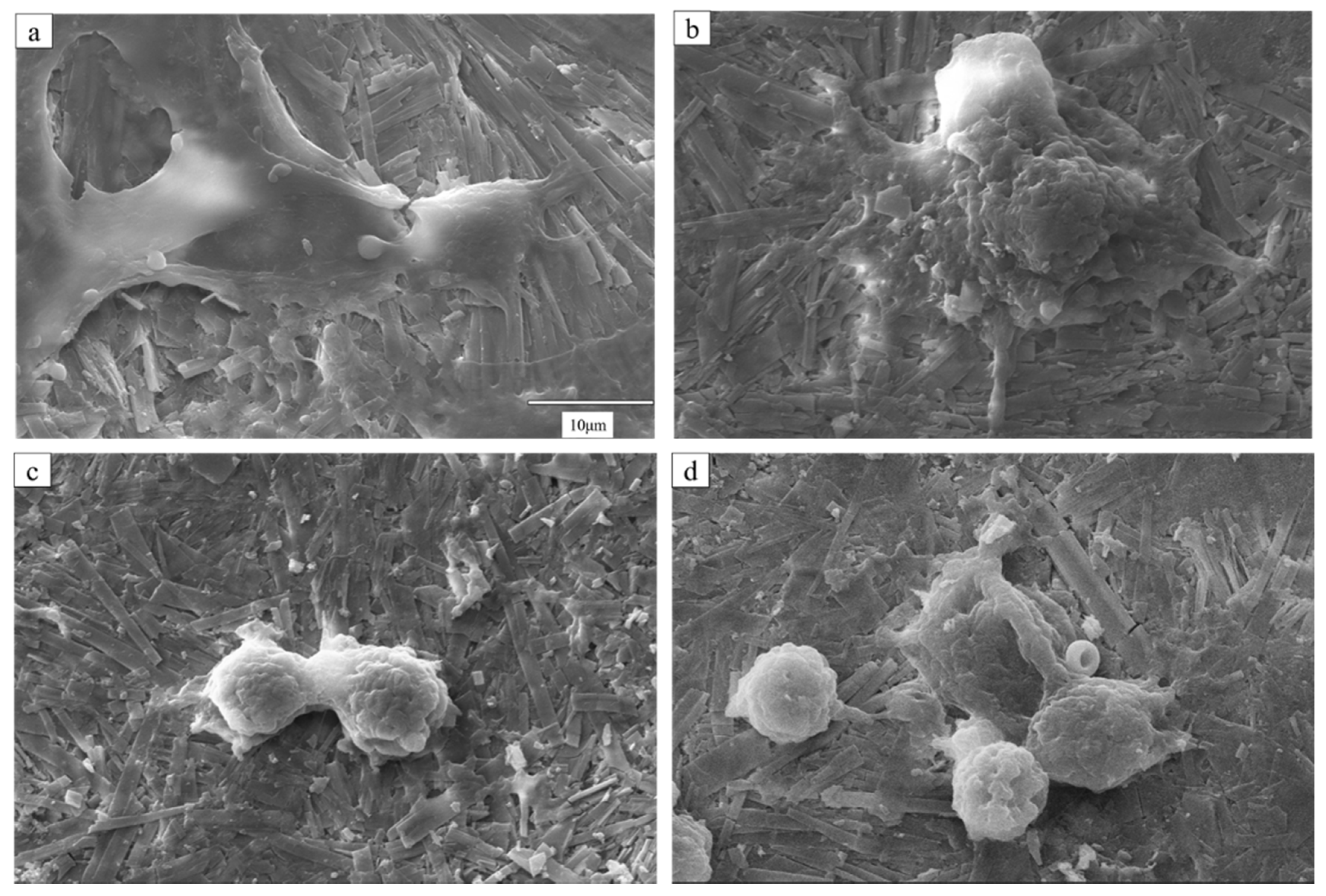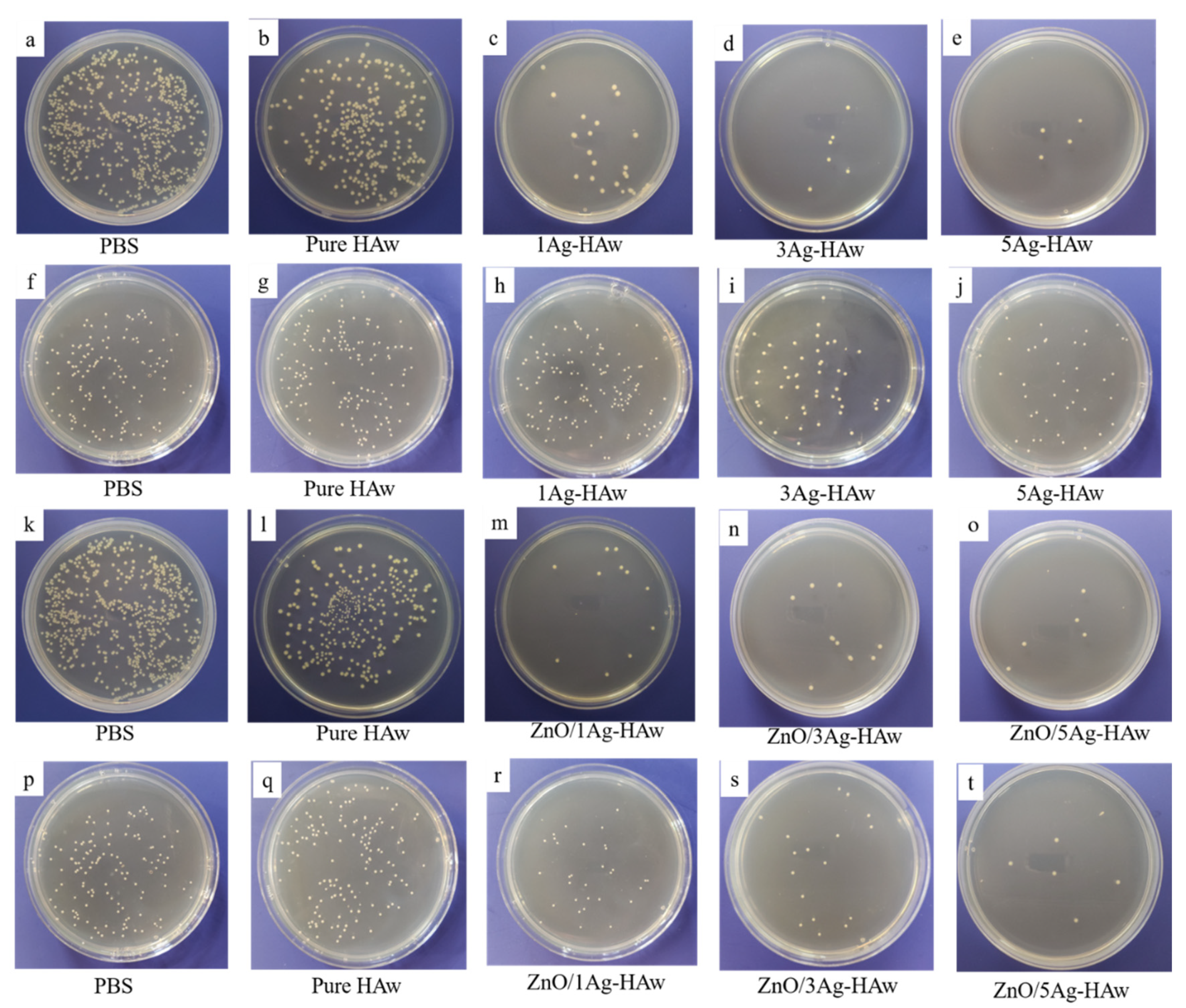Novel Hydroxyapatite Whiskers Modified by Silver Ion and Nano Zinc Oxide Used for Bone Defect Repairment
Abstract
:1. Introduction
2. Material and Methods
2.1. Preparation of Ag-HAw
2.2. Preparation of ZnO/Ag-HAw
2.3. Characterization of ZnO/Ag-HAw
2.4. Cytotoxicity Assessment and Cell Adhesion
- A1: OD value of the experimental;
- A2: OD value of the blank;
- A3: OD value of the control.
2.5. Antibacterial Assessment
- C0: the average number of bacteria cultured in the control;
- Ct: the average number of bacteria cultured in the experimental group.
3. Results and Discussion
3.1. SEM Morphology Analysis
3.2. XRD and ICP-OES Analysis
3.3. In Vitro Cytotoxicity of ZnO/Ag-HAw
3.4. Antimicrobial Assessment
4. Conclusions
- The doping of silver ions results in the lattice distortion and crystallinity decreases of HAw. With the doping of silver ions, the HAw morphology changes from acicular to lath-like and spheroidal. Additionally, the actual doping amount of silver ions decreases as the doping ratio increases.
- The nano zinc oxide could uniformly distribute on the surface of the ZnO/Ag-HAw sample.
- The Ag-HAw and ZnO/Ag-HAw showed non-cytotoxicity. The incorporation of silver ions reduced the cell viability to a certain extent, but the nano zinc oxide can increase the cell viability.
- Ag-HAw and ZnO/Ag-HAw had inhibitory effects on E. coli and S. aureus. However, Ag+ has a more significant antibacterial ability on E. coli.
Author Contributions
Funding
Institutional Review Board Statement
Informed Consent Statement
Data Availability Statement
Conflicts of Interest
References
- Jin, Z.L.; Li, S.L.; Wu, L.I. Performance and Application of the Complex Material Reinforced by Whiskers. J. Salt Lake Res. 2003, 57–66. [Google Scholar]
- Kane, R.J.; Converse, G.; Roeder, R.K. Effects of the reinforcement morphology on the fatigue properties of hydroxyapatite reinforced polymers. J. Mech. Behav. Biomed. Mater. 2008, 1, 261–268. [Google Scholar] [CrossRef] [Green Version]
- Roeder, R.K.; Sproul, M.M.; Turner, C.H. Hydroxyapatite whiskers provide improved mechanical properties in reinforced polymer composites. J. Biomed. Mater. Res. 2003, 67, 801–812. [Google Scholar] [CrossRef]
- Ciobanu, C.; Iconaru, S.; Pasuk, I.; Vasile, B.S.; Lupu, A.; Hermenean, A.; Dinischiotu, A.; Predoi, D. Structural properties of silver doped hydroxyapatite and their biocompatibility. Mater. Sci. Eng. C 2013, 33, 1395–1402. [Google Scholar] [CrossRef]
- Guo, C.; Xue, J.; Dong, Y. Fabrication and characterization of hydroxyapatite nanomaterial dual deposited with nano silver and zinc oxide. Mater. Lett. 2018, 219, 182–185. [Google Scholar] [CrossRef]
- Veljovic, D.; Matic, T.; Stamenic, T.; Kojic, V.; Dimitrijevic-Brankovic, S.; Lukić, M.; Jevtic, S.; Radovanovic, Z.; Petrovic, R.; Janackovic, D. Mg/Cu co-substituted hydroxyapatite—Biocompatibility, mechanical properties and antimicrobial activity. Ceram. Int. 2019, 45, 22029–22039. [Google Scholar] [CrossRef]
- Huang, Y.; Hao, M.; Nian, X.; Qiao, H.; Zhang, X.; Zhang, X.; Song, G.; Guo, J.; Pang, X.; Zhang, H. Strontium and copper co-substituted hydroxyapatite-based coatings with improved antibacterial activity and cytocompatibility fabricated by electrodeposition. Ceram. Int. 2016, 42, 11876–11888. [Google Scholar] [CrossRef]
- Li, Y.; Ho, J.; Ooi, C.P. Antibacterial efficacy and cytotoxicity studies of copper (II) and titanium (IV) substituted hydroxyapatite nanoparticles. Mater. Sci. Eng. C 2010, 30, 1137–1144. [Google Scholar] [CrossRef]
- Wang, J.; Gong, X.; Hai, J.; Li, T. Synthesis of silver–hydroxyapatite composite with improved antibacterial properties. Vacuum 2018, 152, 132–137. [Google Scholar] [CrossRef]
- Hetrick, E.M.; Schoenfisch, M.H. Reducing implant-related infections: Active release strategies. Chem. Soc. Rev. 2006, 35, 780–789. [Google Scholar] [CrossRef]
- Bologna, R.A.; Tu, L.M.; Polansky, M.; Fraimow, H.D.; Gordon, D.A.; Whitmore, K.E. Hydrogel/silver ion-coated urinary catheter reduces nosocomial urinary tract infection rates in intensive care unit patients: A multicenter study. Urology 1999, 54, 982–987. [Google Scholar] [CrossRef]
- Simon, S. Bacterial silver resistance: Molecular biology and uses and misuses of silver compounds. FEMS Microbiol. Rev. 2010, 27, 341–353. [Google Scholar]
- Chen, W.; Liu, Y.; Courtney, H.; Bettenga, M.; Agrawal, C.; Bumgardner, J.; Ong, J. In vitro anti-bacterial and biological properties of magnetron co-sputtered silver-containing hydroxyapatite coating. Biomaterials 2006, 27, 5512–5517. [Google Scholar] [CrossRef]
- Rai, M.; Yadav, A.; Gade, A. Silver nanoparticles as a new generation of antimicrobials. Biotechnol. Adv. 2009, 27, 76–83. [Google Scholar] [CrossRef]
- Badrour, L.; Sadel, A.; Zahir, M.; Kimakh, L.; El Hajbi, A. Synthesis and physical and chemical characterization of Ca10−xAgx(PO4)6(OH)2−xx apatites. Ann. Chim. Sci. Mat. 1998, 23, 61. [Google Scholar] [CrossRef]
- Naresh, S.; Dubey, A.K.; Bikramjit, B. Cellular proliferation, cellular viability, and biocompatibility of HA-ZnO composites. J. Biomed. Mater. Res. B 2011, 100, 256–264. [Google Scholar]
- Li, Y.; Zhang, W.; Niu, J.; Chen, Y. Mechanism of Photogenerated Reactive Oxygen Species and Correlation with the Antibacterial Properties of Engineered Metal-Oxide Nanoparticles. ACS Nano 2012, 6, 5164–5173. [Google Scholar] [CrossRef] [PubMed]
- Zhang, D.; Liu, Y.; Liu, Z.; Wang, Q. Advances in Antibacterial Functionalized Coatings on Mg and Its Alloys for Medical Use—A Review. Coatings 2020, 10, 828. [Google Scholar] [CrossRef]
- Wang, X.H.; Du, Y.M.; Liu, H. Preparation, characterization and antimicrobial activity of chitosan-Zn complex. Carbohydr. Polym. 2004, 56, 21–26. [Google Scholar] [CrossRef]
- Wang, X.; Ito, A.; Sogo, Y.; Li, X.; Oyane, A. Zinc-containing apatite layers on external fixation rods promoting cell activity. Acta Biomater. 2010, 6, 962–968. [Google Scholar] [CrossRef]
- Zhang, Z.H.; Chen, L.; Liu, H.; Chen, C.L.; Wang, S.L.; Huang, Z.L. Preparation and budding growth of whiskers in a homogeneous system. Solid State Sci. 2012, 14, 1277–1281. [Google Scholar] [CrossRef]
- Jacobs, A.; Gaulier, M.; Duval, A.; Renaudin, G. Silver Doping Mechanism in Bioceramics—From Ag+: Doped HAp to Ag°/BCP Nanocomposite. Crystals 2019, 9, 326. [Google Scholar] [CrossRef] [Green Version]
- Helen, S.; Kumar, A.R. Study of structural, mechanical and dielectrical properties of ions doped apatite for antibacterial activity. Mater. Chem. Phys. 2019, 237, 121867. [Google Scholar] [CrossRef]
- Gokcekaya, O.; Webster, T.J.; Ueda, K.; Narushima, T.; Ergun, C. In vitro performance of Ag-incorporated hydroxyapatite and its adhesive porous coatings deposited by electrostatic spraying. Mater. Sci. Eng. C 2017, 77, 556–564. [Google Scholar] [CrossRef] [PubMed]
- Sadat-Shojai, M.; Khorasani, M.-T.; Dinpanah-Khoshdargi, E.; Jamshidi, A. Synthesis methods for nanosized hydroxyapatite with diverse structures. Acta Biomater. 2013, 9, 7591–7621. [Google Scholar] [CrossRef] [PubMed]
- ISO 10993-5 2009 Biological evaluation of medicaldevices —Part 5: Tests for in vitro cytotoxicity.
- Mohiti-Asli, M.; Pourdeyhimi, B.; Loboa, E.G. Novel, silver-ion-releasing nanofibrous scaffolds exhibit excellent antibacterial efficacy without the use of silver nanoparticles. Acta Biomater. 2014, 10, 2096–2104. [Google Scholar] [CrossRef] [Green Version]
- Jamuna-Thevi, K.; Bakar, S.; Ibrahim, S.; Shahab, N.; Toff, M. Quantification of silver ion release, in vitro cytotoxicity and antibacterial properties of nanostuctured Ag doped TiO2 coatings on stainless steel deposited by RF magnetron sputtering. Vacuum 2011, 86, 235–241. [Google Scholar] [CrossRef]
- Yun’An, Q.; Lin, C.; Li, R. Potential antibacterial mechanism of silver nanoparticles and the optimization of orthopedic implants by advanced modification technologies. Int. J. Nanomed. 2018, 13, 3311–3327. [Google Scholar]
- Feng, Q.; Wu, J.; Chen, G.; Cui, F.; Kim, T.; Kim, J. A mechanistic study of the antibacterial effect of silver ions on Escherichia coli and Staphylococcus aureus. J. Biomed. Mater. Res. A 2000, 52, 662–668. [Google Scholar] [CrossRef]
- Jung, W.K.; Koo, H.C.; Kim, K.W.; Shin, S.; Kim, S.H.; Park, Y.H. Antibacterial Activity and Mechanism of Action of the Silver Ion in Staphylococcus aureus and Escherichia coli. Appl. Environ. Microbiol. 2008, 74, 2171–2178. [Google Scholar] [CrossRef] [Green Version]
- Cabeen, M.T.; Jacobs-Wagner, C. Bacterial cell shape. Nat. Rev. Genet. 2005, 3, 601–610. [Google Scholar] [CrossRef]
- Adams, L.K.; Lyon, D.Y.; Alvarez, P.J. Comparative eco-toxicity of nanoscale TiO2, SiO2, and ZnO water suspensions. Water Res. 2006, 40, 3527–3532. [Google Scholar] [CrossRef] [PubMed]
- Li, M.; Xu, Z.P.; Sultanbawa, Y.; Chen, W.; Liu, J.; Qian, G. Potent and durable antibacterial activity of ZnO-dotted nanohybrids hydrothermally derived from ZnAl-layered double hydroxides. Colloids Surf. B 2019, 181, 585–592. [Google Scholar] [CrossRef] [PubMed]
- Hajipour, M.J.; Fromm, K.M.; Ashkarran, A.A.; de Aberasturi, D.J.; de Larramendi, I.R.; Rojo, T.; Serpooshan, V.; Parak, W.J.; Mahmoudi, M. Antibacterial properties of nanoparticles. Trends Biotechnol. 2012, 30, 499–511. [Google Scholar] [CrossRef] [PubMed] [Green Version]






| Sample (Composition) | Ca(NO3)2·4H2O (g) | (NH4)2HPO4 (g) | Sorbitol | Urea | Silver Nitrate |
|---|---|---|---|---|---|
| Pure HAw (0 mol.% Ag) | 15.6638 g (0.0670 mol) | 5.2824 g (0.04 mol) | 0.8036 g | 18 g | 0 g (0 mol) |
| 1Ag-HAw (1 mol.% Ag) | 15.3474 g (0.06633 mol) | 5.2824 g (0.04 mol) | 0.8036 g | 18 g | 0.1137 g (0.00067 mol) |
| 3Ag-HAw (3 mol.% Ag) | 15.4337 g (0.06499 mol) | 5.2824 g (0.04 mol) | 0.8036 g | 18 g | 0.34110 g (0.00201 mol) |
| 5Ag-HAw (5 mol.% Ag) | 15.0301 g (0.06365) | 5.2824 g (0.04 mol) | 0.8036 g | 18 g | 0.5685 g (0.00335 mol) |
| Scheme | Cell Parameters | Crystallinity | ||
|---|---|---|---|---|
| a = b (Å) | c (Å) | c/a | - | |
| Pure HAw | 9.4134 | 6.8901 | 0.7319 | 78.63% (±0.33) |
| 1Ag-HAw | 9.4211 | 6.8911 | 0.7316 | 75.51% (±2.59) |
| 3Ag-HAw | 9.4212 | 6.8886 | 0.7312 | 74.85% (±1.86) |
| 5Ag-HAw | 9.4221 | 6.8924 | 0.7315 | 72.95% (±2.90) |
| Sample | Ag/(Ag + Ca) Theoretical Value | Ag/(Ag + Ca) Actual Value | MIXING RATIO |
|---|---|---|---|
| Pure HAw | 0 | 0 | - |
| 1Ag-HAw | 1% | 0.73% | 73% |
| 3Ag-HAw | 3% | 1.54% | 51% |
| 5Ag-HAw | 5% | 2.23% | 45% |
| Sample | Ppm |
|---|---|
| 1Ag-HAw | 0.35 |
| 3Ag-HAw | 0.43 |
| 5Ag-HAw | 0.51 |
| Group | Number of Colonies | Inhibition Rate |
|---|---|---|
| PBS | 211.33 ± 8.50 | - |
| Pure-HAw | 195.67 ± 5.86 | 7.4% |
| 1Ag-HAw | 18 ± 2 | 91.5% |
| 3Ag-HAw | 6.3 ± 1.53 | 97.1% |
| 5Ag-HAw | 4.67 ± 1.53 | 98.7% |
| Group | Number of Colonies | Inhibition Rate |
|---|---|---|
| PBS | 171 ± 13.53 | - |
| Pure-HAw | 159.7 ± 4.51 | 6.6% |
| 1Ag-HAw | 101 ± 3.61 | 40.1% |
| 3Ag-HAw | 48 ± 6.56 | 71.9% |
| 5Ag-HAw | 30.3 ± 2.52 | 82.5% |
| Group | Number of Colonies | Inhibition Rate |
|---|---|---|
| PBS | 211.33 ± 8.50 | - |
| Pure-HAw | 195.67 ± 5.86 | 7.4% |
| ZnO/1Ag-HAw | 11.67 ± 2.08 | 94.7% |
| ZnO/3Ag-HAw | 8.33 ± 0.58 | 96.2% |
| ZnO/5Ag-HAw | 4.67 ± 0.56 | 97.8% |
| Group | Number of Colonies | Inhibition Rate |
|---|---|---|
| PBS | 171 ± 13.53 | - |
| Pure-HAw | 159.7 ± 4.51 | 6.6% |
| ZnO/1Ag-HAw | 27 ± 4.59 | 84.2% |
| ZnO/3Ag-HAw | 18 ± 2 | 89.4% |
| ZnO/5Ag-HAw | 7 ± 1.53 | 95.9% |
Publisher’s Note: MDPI stays neutral with regard to jurisdictional claims in published maps and institutional affiliations. |
© 2021 by the authors. Licensee MDPI, Basel, Switzerland. This article is an open access article distributed under the terms and conditions of the Creative Commons Attribution (CC BY) license (https://creativecommons.org/licenses/by/4.0/).
Share and Cite
Yan, T.; Jiang, Z.; Li, P.; Chen, Q.; Zhou, J.; Cui, X.; Wang, Q. Novel Hydroxyapatite Whiskers Modified by Silver Ion and Nano Zinc Oxide Used for Bone Defect Repairment. Coatings 2021, 11, 957. https://doi.org/10.3390/coatings11080957
Yan T, Jiang Z, Li P, Chen Q, Zhou J, Cui X, Wang Q. Novel Hydroxyapatite Whiskers Modified by Silver Ion and Nano Zinc Oxide Used for Bone Defect Repairment. Coatings. 2021; 11(8):957. https://doi.org/10.3390/coatings11080957
Chicago/Turabian StyleYan, Tingting, Zhimin Jiang, Pan Li, Qinghua Chen, Jing Zhou, Xiuzhen Cui, and Qiang Wang. 2021. "Novel Hydroxyapatite Whiskers Modified by Silver Ion and Nano Zinc Oxide Used for Bone Defect Repairment" Coatings 11, no. 8: 957. https://doi.org/10.3390/coatings11080957
APA StyleYan, T., Jiang, Z., Li, P., Chen, Q., Zhou, J., Cui, X., & Wang, Q. (2021). Novel Hydroxyapatite Whiskers Modified by Silver Ion and Nano Zinc Oxide Used for Bone Defect Repairment. Coatings, 11(8), 957. https://doi.org/10.3390/coatings11080957







